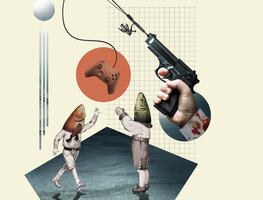Más Información

Alito Moreno se reúne con familiares de prisioneros de Israel en Marruecos; pide su liberación antes de Navidad

SEP debe informar sobre objetos peligrosos en revisiones escolares: Inai; violencia escolar ha ido en aumento

Videojuegos, el nuevo gancho del crimen para captar menores; los atraen con promesas de dinero y poder

“Vamos a dar apoyo a los pequeños agricultores por sequía en Sonora”; Claudia Sheinbaum instruye a Berdegué
Members of the Maya elite participated in major events taking place in the ancient city of Teotihuacán , according to recent archeological findings that shed light on the relationship between Teotihuacan and Maya cultures, stated the National Institute of Anthropology and History (INAH) through a press release.
As part of a conference cycle called “La arqueología hoy” (Archeology Today) which took place in the National College , a team of scientists presented updates of their “Plaza de las Columnas” project, led by Japanese archeologist Saburo Sugiyama , from the Arizona State University and the Aichi University in Japan .
Anthropologist Nawa Sugiyama
, from the California-Riverside University , spoke about the progress made in the multidisciplinary project.
Sugiyama revealed four findings which prove that Maya elites participated in great public events at Teotihuacán’s “Plaza de las Columnas” before what is known as “The Entry,” a historic event told by Davis Stuart based on a thorough study of the Stela 31, from the Maya city of Tikal, in Guatemala .
According to Stuart, on January 14, 378 AD , Siyaj K’ak,’ a messenger to Teotihuacan king Átlatl-Cauac (Dart-throwing Owl), arrived in Tikal on the day of the death of its ruler, Chak Tok Ich’aak.
This historic event allegedly marked the beginning of a close relationship between both cultures.
The first finding mentioned by Sugiyama, which challenges said chronology, consists of more than 2,400 human remains located at the A1 Offering archeological site. Among the remains, archeologists found teeth with metal inlays and others that had been sharpened deliberately.
Sugiyama mentioned that there were at least three skulls that showed cranial deformation via head binding, which is quite significant considering that this sort of alteration, along with dental mutilations were uncommon in Teotihuacan, though they were normal practices in the Maya territory.
The human remains are currently being analyzed to asses their exact origin.
The second finding consists of a large ceramic deposit labeled “Ofrenda D1” (D1 Offering) , likely a remnant from a large festivity. A total of 3,500 bones were found, mostly from animals, along with 10,000 broken “tepalcate” vases, probably destroyed as part of a ritual.
Furthermore, different types of foreign lime and plaster were found with iconographic components of Mayan origin.
Some animal remains found at the site proved that a feast of rabbits and quails had been offered in the City of the Gods. Moreover, a paleobotanic analysis indicated that the Teotihuacans had imported foreign products such as cassava and tobacco for the special occasion.
“Said festivities offered an opportunity to interact with other cultures and build alliances. The newly found information on their ritual food consumption reveals the socio-political and symbolical structures underlying their society,” the anthropologist commented.
On the other hand, a series of wall fragments with mural paintings of Mayan origin were also found, though they were likely demolished on purpose. Scientists are now analyzing more than a thousand wall fragments for restoration and scanning.
Another finding, known as the D4 Offering , includes pieces of stone associated with marine elements and animal remains, including the skeleton of a spider monkey, a species that is not native to the central region of Mesoamerica.
dm







